General Major Hermann Pürckhauer
On the subforum “Dieter Zinke Axis Biographial research, there are many threads about officers in the Wehrmacht. here is one of them. Dont´miss this Subforum if you are interested in officers of the Wehrmacht.
//Georg
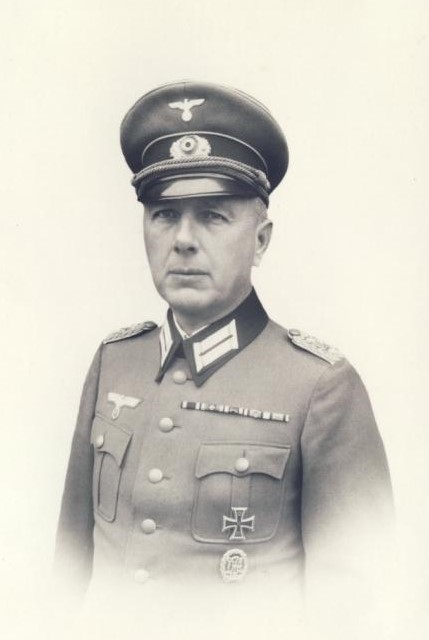
Hermann Pürckhauer
* 15.02.1897 Forchheim
† 03.12.1943 München
00.00.1915 Fahnenjunker
11.03.1916 Leutnant (Patent vom 23.02.1915)
01.10.1920 Leutnant (Rangdienstalter auf den 01.09.1915 festgelegt)
Ende 07.1925 Oberleutnant (Rangdienstalter auf den 01.04.1925 festgelegt)
01.03.1931 Hauptmann
01.01.1936 Major
01.02.1939 Oberstleutnant
01.12.1940 Oberst
00.00.1943 Generalmajor posthum (RDA vom 01.12.1943)
Eltern: Dr. med. Hermann Pürckhauer & Frau, geb. von Liebig
00.00.1915 Eintritt in das 2. Königlich Bayerische Infanterie-Regiment “Kronprinz“, München (Kaserne Lothstraße);
Zugführer
01.06.1917 Kompanieführer
20.08.1918 – 15.02.1920 in französischer Kriegsgefangenschaft
00.00.1920 beim 2. bayer. Reichswehr-Schützen-Regiment 42 unter der Reichswehr-Brigade 21, München, der Vorläufigen Reichswehr, die im Juni 1919 aus Einheiten des Freikorps von Epp (Bayerisches Schützenkorps) gebildet worden war
01.10.1920 Kompanieoffizier beim 19. (Bayerischen) Infanterie-Regiment , München
Frühjahr 1924 in der 12. (MG.) Kompanie des 19. (Bayerischen) Infanterie-Regiments, Kempten
00.00.1926 Adjutant des III. (Jäger-) Bataillons des 19. (Bayerischen) Infanterie-Regiments, Kempten
01.10.1929 Kompaniechef der 12. (MG.) Kompanie des 19. (Bayerischen) Infanterie-Regiments, Kempten
01.10.1932 im Stab der 7. Division, München
01.10.1937 Kommandeur des II. Bataillons des Infanterie-Regiments 61, München
15.01.1940 Führerreserve
29.04.1940 Adjutant des Stellvertretenden Generalkommandos VII. Armeekorps, München
01.10.1941 Kommandeur des Infanterie-Regiments 61
16.10.1942 Führerreserve
01.09.1943 Kommandeur der Annahmestelle für Offiziersbewerber VII, München
03.12.1943 in München verstorben
Verheiratet seit 23.04.1924 mit Frieda geb. Hindelang
Verwundetenabzeichen in schwarz
Kgl. Bayer. Militär-Verdienstorden IV. Klasse mit Schwertern
Spangen zu beiden Eisernen Kreuzen
18.06.1942 Deutsches Kreuz in Gold
Drones a novelty in the military?
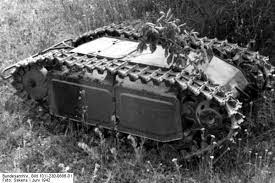
Considering the development in a nearby war where Drones get a more active role in the times, one can ask, is this the new way to fight? I have to say, No! During the Second World War, the German army used the Sd.Kfz 302 or 303. A radio-controlled explosive charge that drove with its caterpillar feet to the desired location and then detonated.
It began development in 1940 by the Borgward firm of Bremen who had been approached by the German Army for the design of a “demolition vehicle”.
The engineer Adolphe Kegrésse had built an experimental vehicle that was seized after the collapse of France and it was this that became the basis for the German variant.
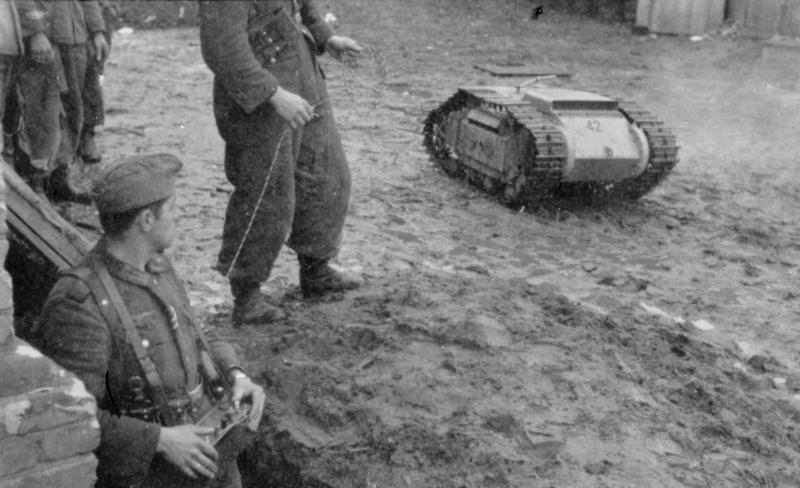
A year and a half later, the German model was ready for use, the official name was Leichter ladungsträger Sd.Kfz 302 but also received the additional name “Goliat”.
However, like all new machines, it had some childhood illnesses, among other things. so the fighting troops criticized its weight (365kg) and that the cables with which the Goliat was controlled were too weak.
With this Borgward developed a new prototype, with lighter weight and improved cables the new model was named Sd.Kfz 303 “Goliat”. The first working name for the vehicle was initially David, but that caused the Ministry of Propaganda to have hiccups. You couldn’t name something like that after a heroic Jewish boy who took down Goliath. For some reason, ironically, the name Goliath was adopted.
From 1943 onwards, a total of 4900 Goliaths were produced and they were active in the battles from Kursk to the final battle in Berlin in 1945. It is noted that they were used extensively during the Battle of Warsaw in 1944, where they knocked out houses in which the Polish Home Army was entrenched.
As the introduction said, drones are not a new invention.
//Georg
SS-Standort Arolsen (part 3 and the end)
January 00, 1943
Both the accommodation and distribution of the regiment at the locations in Arolsen, Korbach, Warburg and Wildflecken (II and III Divisions) as well as the equipment caused difficulties.
After the destruction of the barrier wall, parts of the regiment were deployed on rescue and recovery work in the Edertal from May 17th to May 25th, 1943.
(Bernd Joachim Zimmer, code name Arthur – The concentration camp external command in the SS leader school Arolsen, Verlag Gesamthochschul-bibliothek Kassel, 1994 p. 45)
In June 1943 the replacement regiment was moved to Munich.
(Bernd Joachim Zimmer, code name Arthur – The concentration camp external command in the SS leader school Arolsen, Verlag Gesamthochschul-bibliothek Kassel, 1994, p. 45, in contrast to the SS-VT “Germania”, the regiment has no deeper memories among the Arols population leave behind)
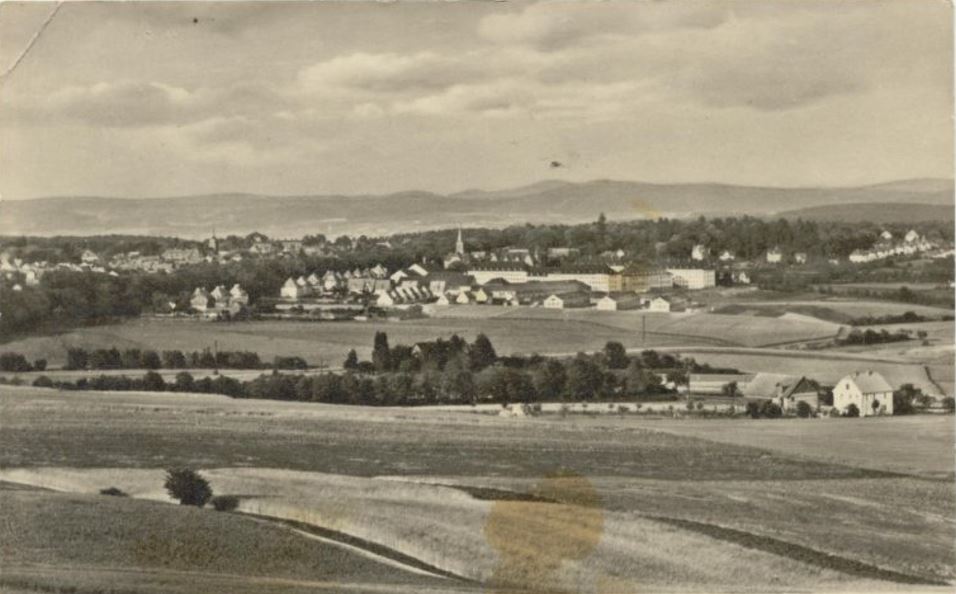
July 00, 1943
Relocation of the SS Flak Replacement Regiment in June to July 1943 to Munich-Freimarn to the barracks of the SS Regiment “Germany”, which was only completed in 1935 and was in use until June 1st. In 1943 it served as accommodation for the SS Artillery Replacement Regiment that was relocated to Prague.
In terms of size, this barracks was also able to accommodate the extremely strong units of the anti-aircraft training and replacement regiment; meaningful and concentrated training could be carried out here.
Later, however, barracks had to be built here to accommodate the recruits. The strength of the regiment at this time was approximately 6,000 men.
Since the final structure had not yet been determined, the batteries were named after the names of their leaders, for example the battery “Dreike”, “Wunderlich” or “Graupner”.
This was followed by a short-term occupancy with the newly formed SS Panzer Reconnaissance Training Department 2, which, however, withdrew from Arolsen on September 13, 1943 and was relocated to the SS military training area “Seelager”.
(Bernd Joachim Zimmer, code name Arthur – The concentration camp external command in the SS leader school Arolsen, Verlag Gesamthochschul-bibliothek Kassel, 1994, p. 45)
Wilhelm Tieke, after basic training in 1940 with the SS Motorcycle Rifle Replacement Battalion Ellwangen then with the 15th/“Nordland”, came after being wounded on February 4, 1943 via various hospitals, most recently Res.Laz. Brieg until the summer of 1943, after a convalescent vacation at home, to the reserve unit: “… Ellwangen an der Jagst, the starting point of my soldiering, has me back.
But soon I will be transferred to Arolsen with other old front hands to set up a new one, Reconnaissance, Training and Replacement Department 2.
Arolsen is a small garrison town in Waldeckschen. The “Germania” battalion was once located here and then the anti-aircraft replacement and training department, which was expanded into a regiment and relocated to Munich.
The new department, led by Hauptsturmführer Keitel, is still in its early stages. Even the supporting staff is not yet fully available and so there is only a lukewarm service. Tattooing is only on paper for the time being, because UvD and those on guard are provided by us squad leaders and storm men, and as is well known, “one crow doesn’t peck out the eyes of another”. We get up to all sorts of mischief…”
Among other things, this resulted in a curfew of fourteen days for the entire department. But “motorcycle driving schools” are also run, even with night rides.
“…One day the skeleton of the company will be in place. Recruits arrive, but soon it is announced that all tank and reconnaissance replacement departments of the Waffen-SS will be relocated to Latvia, including our department…”
(Wilhelm Tieke, A restless march was our life, Munin-Verlag, Osnabrück, 1977, pp. 199, 204, 209-211)
The above-mentioned Hauptsturmführer “Keitel” was the SS-Hstuf at the time. Friedrich Keidel.
Keidel, Friedrich SS- Stubaf. 9. 9.1895 KIA 8.4421.8.1944 In Kurland as part of the SS-Pz.Brig. “Gross”

On November 14, 1943, a prisoner transport was set off from the Weimar-Buchenwald camp to Arolsen in order to complete the preparatory work for the relocation of the SS leadership school of the economic and administrative service from Dachau.
(Bernd Joachim Zimmer, code name Arthur – The concentration camp external command in the SS leader school Arolsen, Verlag Gesamthochschul-bibliothek Kassel, 1994, p. 51)
In January 1944, after the renovations were completed, the school began operating in Arolsen, which continued until the end of March 1945.
(Bernd Joachim Zimmer, code name Arthur – The concentration camp external command in the SS leader school Arolsen, Verlag Gesamthochschul-bibliothek Kassel, 1994, p. 86)
In addition to the SS leader school, an SS clothing warehouse was relocated to Arolsen at the end of 1943 as a branch of the SS clothing factory in Dachau.
(Bernd Joachim Zimmer, code name Arthur – The concentration camp external command in the SS leader school Arolsen, Verlag Gesamthochschul-bibliothek Kassel, 1994, p. 108)
After a combat group made up of members of the school and course participants was formed on January 30th, 1945 with the keyword “Gneisenau”, which was relocated to the Oder front, the last two combat groups from the school moved out on Monday, March 26th, 1945, assembled from, among others The remaining 200 SS members, slightly ill people and soldiers from a front-line holiday train were deployed against the advancing American troops in the direction of Marburg.
(Bernd Joachim Zimmer, code name Arthur – The concentration camp external command in the SS leader school Arolsen, Verlag Gesamthochschul-bibliothek Kassel, 1994, pp. 289, 290)
On March 29, 1945, the Arolsen prisoner external command, which had existed since the SS leader school was there, was relocated back to Weimar-Buchenwald.
(Bernd Joachim Zimmer, code name Arthur – The concentration camp external command in the SS leader school Arolsen, Verlag Gesamthochschul-bibliothek Kassel, 1994, p. 293ff)
Around midnight on Good Friday, March 30, 1945, the shelling of the city center of Arolsen began with grenades, but there were no casualties among the civilian population and the damage to the post office, pharmacy and some commercial buildings remained minimal.
On March 30, 1945, the city of Arolsen was occupied by American troops.
(Bernd Joachim Zimmer, code name Arthur – The concentration camp external command in the SS leader school Arolsen, Verlag Gesamthochschul-bibliothek Kassel, 1994, p. 302)
… the SS barracks in Arolsen were officially called Germania barracks and were located on the corner of Große Allee and Kasernenstraße (today Birkenweg)
The barracks, built in 1870 for the Wittich (3rd Kurhessisches) Infantry Regiment No. 83, were greatly expanded in the mid-1930s. From 1933 an SA relief organization and an SA sports school were housed there until the SS claimed ownership of the area in 1935 and the city terminated the SA’s lease.
Below is a plan of the barracks from 1937. During its use as an SS leader school from autumn 1943, the occupancy was as follows:
Blocks A, B: command staff, headquarters company
Blocks C,D,F,G: Accommodation for course participants
Block E: Administration of the SS clothing warehouse
S: Stables
R: Riding hall
HS: Woodshed (to SS clothing warehouse)
Quelle: Lagis Hessen
http://forum-der-wehrmacht.de/thread.php?postid=360356#post360356
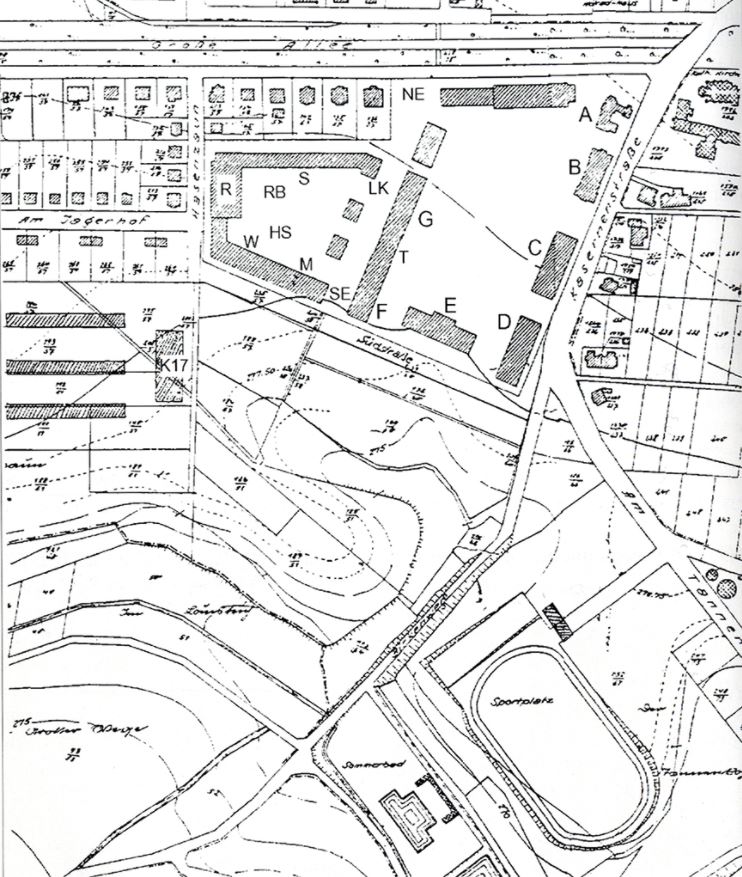
The end
Auhtor and Images Roland Pfeiffer
SS-Lazarett Karlsbad
In 1940 so was the SS-Genesungsheim Karlsbad, it held that name until 1942 when it changed the name into SS-Lazarett-Abteilung Karlsbad which it held for the rest of the war. The Lazarett had a capacity of 174 beds. The hspital was specialized in stomache and gut dieases. But they also treated Malaria at the hostpital.
Who held the leading roll of an Doctor from 1940 to 1944 is unfortunately unknown, but from 1944 the positions was held by SS-Stubaf Dr.Med. Walter Platt. He was in october 1944 replaced by SS-Stubaf Dr.Med Robert Kronenberg. In 1945 the leading Dr at SS-Lazarett-Abteilung Karlsbad was the SS-Ostubaf Dr.Med. Stoll.
Info about Dr´s SS-Stubaf Dr Walter Platt later promoted to SS-Staf, born 17.5.1889 in Mühlhausen SS-Nr
199183. Dr Robert Kronenberg SS-Stubaf born: 2.1.1889 in Prag.
In my manucript of K I have the following listed about Dr Kronenberg –
SS-Nr 255788 NSDAP Nr 2562696 Joined the SS in 1940 was attached to the SS-San.Er.Abt. Prag between 1940-1941. Later he came to SS-Sanitätsamt where he was between 1941-1942. He was then transfered to the SS-Lazarett in Minsk. That service was very short and he was later transfered back to the SS-San.Ers.Abt. later in 1942 he came to SS-Genesungsheim Karlsbad for the first time. But also that was a short service as he was once again transfered to SS-Genesungsheim Winterberg.
After tath was he transfered to the SS-Standort Oberarzt in Breslau. But after that he was transfered to the SS-Ausb.Rgt in Prag. when he left that service is unknow. He was at SS-Laz.KArlsbad to 24.10.1944 when he was released from service in the Waffen-SS.
He was awarded the EK II and verwundetabzeichen im Schwarz. He got promoted to SS-Stubaf on 30.1.43 and SS-Hstuf when he entered sercvice in the Waffen-SS 20.4.1940. He was married but no childrens is listed.
//Georg Schwab
Sources : Nachlass W.Vopersal N756- 304b and SSO Kronenberg, Robert in my personal archive.
SS-Standort Arolsen (part 2)
September 9, 1940
Relocation of the AA-MG replacement company to Arolsen/Waldeck
Waffen SS Command, Ia TgbNo. 1024/40 go v. September 9, 1940
Re: Relocation of the anti-aircraft machine gun company
1.) The AA-MG replacement company will be relocated from the SS accommodation “Germania”, Munich to Arolsen, SS barracks with immediate effect.
2.) The transport of the AA-MG-ErsKomp including weapons, equipment, clothing and equipment is to be carried out as a training trip with motor vehicles.
3.) If transport according to point 2 is not possible, rail transport must be registered.
4.) Accommodation in Arolsen is to be taken over by the Fla-Mg-ErsKomp advance command.
5.) The anti-aircraft machine gun replacement company is economically assigned to the Pz.-Jäger-Ers.-Abt at the time of transfer.
The billing for the month of August is to be carried out by the SS-Standarte “Deutschland” administration.
The chief of staff signed Jüttner, SS brigade leader
In the course of clearing the SS barracks Munich-Freiman for the installation of the SS standard “Westland”, the SS-Fla-MG-Ers.Kp. According to the order of the Waffen-SS command on August 9, 1940 in the motorized march to Arolsen.
There the company, SS-Ostuf. Fend, economically assigned to the SS-PzJgErsAbt. Accommodation will initially take place in a gymnasium until appropriate accommodation options are created on the barracks grounds. (WV)
The company was in the barracks of the III./Infanterie-Regiment 83 before the First World War, then that of the II./SS-Standarte “Deutschland”.
At the beginning of September 1940, the SS anti-aircraft machine gun replacement company that had been set up in Munich immediately after the start of the war was moved to the Arols barracks and expanded into an SS anti-aircraft machine gun department.
(Bernd Joachim Zimmer, code name Arthur – The concentration camp external command in the SS leader school Arolsen, Verlag Gesamthochschul-bibliothek Kassel, 1994, p. 45)
At the beginning of 1941, the expansion and formation of an SS anti-aircraft replacement department began.
Department Commander. SS-Hstuf.d.R Franz Jaegy 00.00.41 – 00.00.42
Adjutant: SS-Ostuf. Ball 00.00.41 – 00.00.42
Ordnance officer: SS-Ustuf. Stern 00.00.42 – 00.00.42
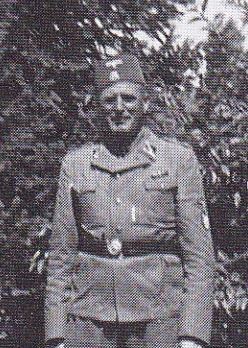
Chief of Staff Battery: SS-Ostuf.d.R.Max Daumer 00.00.41 – 00.00.00
SS-Ostuf. Seriously 00.00.00 – 00.00.00
SS-Ostuf. Wendt 00.00.00 – (00.07.42)
Chief 1st Battery (8.8.cm): SS-Ostuf.d.R.Dr.Wolfgang Loenicker 00.00.41 – 00.00.42
SS-Ostuf.Herbers 00.00.42 – 00.00.42
Chief 2nd battery (3.7 cm): SS-Ostuf.d.R. Karl Bergrath 00.00.41 – 00.03.42
Chief 3rd Battery (2 cm): SS-Ostuf.Schettgen 00.00.41 – 00.00.42
The recruits received their basic training in the three gun batteries and were trained as gunners. The training period was 8 weeks.
In addition to the basic infantry training, radio operator, telephone and motor vehicle training was carried out in platoons in the staff battery.
In the spring of 1941, the first twenty young leaders trained for anti-aircraft guns arrived in Arolsen, 10 as measurement and battery officers for the heavy batteries and 10 for the light anti-aircraft weapons.
April 1, 1941
On April 1, 1941, the department moved to the barracks in Unna/Westphalia that had been left empty due to the relocation of the SS News Replacement Department.
In April 1941, this department was briefly relocated to the empty barracks in Unna, but returned to Arolsen with effect from August 15, 1941.
(Bernd Joachim Zimmer, code name Arthur – The concentration camp external command in the SS leader school Arolsen, Verlag Gesamthochschul-bibliothek Kassel, 1994, p. 45)
June 1, 1941
Appendix 1 to Ordinance Gazette No. 10, Volume 2 v. 1.6.41, changes and additions according to Ordinance Bulletin. No. 16, 1.9.41 and No. 22, 1.12.41
(Mehner, pp.54-56, see also Jörg-M.Hormann, The Ordinance Gazette of the Waffen-SS – A Selection, Fitsch-Form-Verlagsgesellschaft Hannover, 1980)
SS-Panzerjäger-ErsAbt Arolsen
As of June 1, 1941, the SS-Pz.Jg.Ers.Abt. Arolsen responsible replacement unit for everyone
Tank destroyer divisions
Tank destroyer companies and
Tank destroyer platoons
of the field troops of the Waffen-SS, except for the corresponding tank destroyer units of the SS Police Division.
Their replacement unit moved from Königshütte to the Netherlands in April 1941 after Silesia had to be cleared for the deployment against the Soviet Union. The SS-Pol.-Pz.Jg.Ers.Kompanie and the SS-Pol.Pz.Jg.Zug were now in Weerdt.
The days of the SS-Pz-Jg.Ers.Abt in Arolsen are also numbered. The SS Arolsen barracks is intended as future accommodation for the SS anti-aircraft replacement department currently in Unna. (WV)
June 1, 1941
Appendix 1 to Ordinance Gazette No. 10, Volume 2 v. 1.6.41, changes and additions according to Ordinance Bulletin. No. 16, 1.9.41 and 22, 1.12.41 (Mehner, p.54-56)
SS-Flak-Ers.Abt Unna, later Arolsen
According to V.Bl.d.W.-SS, 2nd year, 1941, No. 10 from June 1, 1941, appendix 1 to number 236
List of the responsible replacement units of the Waffen-SS
is the SS-Flak-Ers.Abt. Unna responsible replacement troop unit for
all members of the Flak-Abt. and unit. (without anti-aircraft gun, s.SS-Kraftfahr.Ers.Abt) including message men etc.
(Jörg-M.Hormann, The Ordinance Gazette of the Waffen-SS – A Selection, Fitsch-Form-Verlagsgesellschaft Hannover, 1980)
July 5, 1941
Relocation of the “SS Panzerjäger Replacement Department” to the Dordrecht area in the Netherlands.
At the beginning of July 1941, the order was issued to relocate the SS-PzJgErsAbt from Arolsen to the Netherlands. A little later, the railway transport department moved to its new locations. When it arrives in the Netherlands, the department is tactically and operationally subordinate to the “Commander of the Waffen-SS in the Netherlands”.
Accommodation takes place in makeshift accommodation in the Dordrecht area. (WV)
July 16, 1941
SS-FHA, KdoAmt d. W SS, Abbot Ia/Be/Oe, Tgb.No. 2825/41 belongs to 16.7.41 Composition of the Waffen SS with the repeal of the Vfg. SS-FHA, Ia/G/Keu, TgbNr.1484/41 geh.v.22.4.41 (Hausser, Swaa, p. 291 ff)
SS-FlakErsAbt Unna
August 15, 1941
V.Bl.d.W.-SS, 2nd year, 1941, No. 15 from August 15, 1941, number 317 change of address
The new address of the SS-Flak-E.-Abt. is
SS Flak E. Department
Arolsen/Waldeck
SS barracks Kdo.d.W-SS office
(Jörg-M.Hormann, The Ordinance Gazette of the Waffen-SS – A Selection, Fitsch-Form-Verlagsgesellschaft Hannover, 1980)
April 20, 1942
SS-FHA, KdoAmt d. Waffen SS, OrgTgbNo. 2302/42 belongs to April 20, 1942:
Re: Setting up a convalescent battery of the SS-Flak-ErsAbt
Reference: Application from the SS-Flak-ErsAbt dated April 16, 1942
1.) At the request of the SS-Flak-ErsAbt, the establishment of a “convalescent battery” was approved for this unit in the SS barracks in Unna/Westphalia with effect from April 25, 1942.
2.) The commander must keep the battery at its lowest strength.
A KSTN and KAN does not apply to filling positions.
3.) The convalescent battery is disciplinarily subordinate to the Kdr of the SS-Flak-ErsAbt.
The chief of staff, signed Jüttner, SS group leader and lieutenant general of the Waffen SS
F.d.R. signed Fick, SS-Obersturmbannführer
Whether this convalescent battery is according to the orders of the SS Gruf. and Gen.Lt. d. W-SS Krüger, SS-FHA, Kdo.Amt d. W-SS, Abbot I d, Ref. 34d v. 13.4.42, division of the convalescent companies into 4 platoons, it cannot yet be said:
I. Platoon men who will be kv again in the foreseeable future, up to 4 weeks
II platoon men who will only be commissioned again after a long time
III platoon men who are no longer commissioned
IV. Platoon receiving platoon, with the task of receiving the SS men coming from the hospitals and assigning them to the I., II. or III. platoon depending on their level of suitability (BA NS 756/ 345)
In December 1942 the department was expanded into an SS anti-aircraft replacement regiment under the leadership of SS-Standartenführer Burk.
(Bernd Joachim Zimmer, code name Arthur – The concentration camp external command in the SS leader school Arolsen, Verlag Gesamthochschul-bibliothek Kassel, 1999, p. 45)
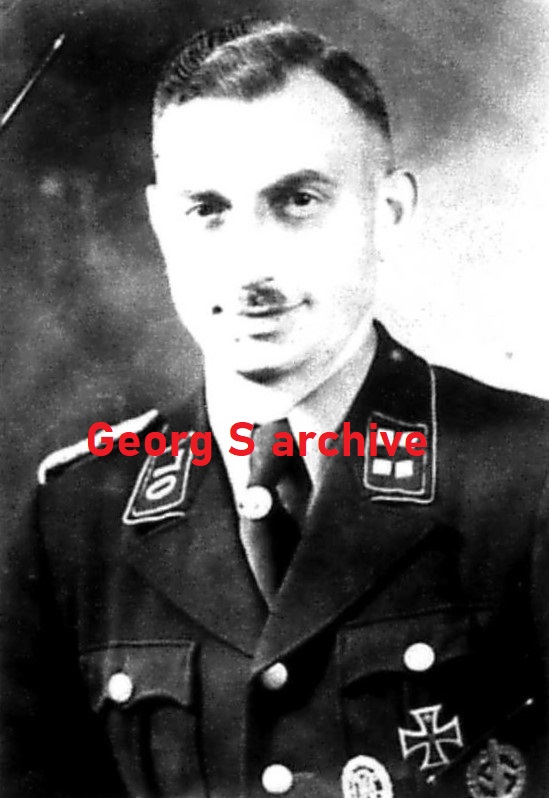
December 4, 1942
By order of the SS-FHA, Berlin-Wilmersdorf, Kaiserallee 188; The reorganization of the SS Flak Replacement Department into an SS Flak Replacement Regiment was ordered.
SS-FHA, KdoAmt d. Waffen SS, OrgTgbNo. 8071/42 belongs to December 4, 1942:
Re: Reorganization of the SS Flak Replacement Division into an SS Flak Replacement Regiment
Reference: SS-FHA, Org.Tgb.No. 34/41 g.Kdos v. 02/11/41
SS-FHA, Org.Tgb.No. 1180/41 go to v. 04/08/41
SS-FHA, Org.Tgb.No. 1798/41 go to v. 05/14/41
SS-FHA, Org.Tgb.No. 5010/41 belongs to 11/22/41
1.) With effect from March 11, 1943, the SS Flak Replacement Division ordered to be set up and expanded in the above-mentioned orders will be reclassified into an SS Flak Replacement Regiment.
2.) The following will be reclassified:
1 staff Flak-ErsAbt KSTN and KAN 2912 (L) from. 1.4.39 in
1 Staff Army Flak Artillery Replacement Regiment KSTN and KAN 6213 v. 1.4.41
1 Stabs- und Nachr.Bttr of a Flak-ErsAbt KSTN and KAN 2917 (L) from. 1.4.39 in
1 measuring battery HeerFlakartErsRgt from KSTN and KAN 6237 v. 1.4.42
only a) group leader and b) intelligence replacement platoon,
in addition from Kraftfahr-ErsKp KSTN and KAN 6631 v. 1.4.41
c) 1st move
1 Flak-ErsBttr (5 Gesch 8.8cm) after KSTN and KAN 2925 (L) from. 1.4.39 in
1 Army FlakErsBttr (8.8 cm) KSTN and KAN 238 BC 1.6.41
plus from measuring battery HeerFlakArtErsAbt KSTN and KAN 6237 v. 1.4.42
d) Flight evaluation replacement train
1 Flak-Ers.Bttr (9 stories 3.7 cm) according to KSTN and KAN 2923 (L) from. 1.4.39 in
1 Heer Flak.Ers.Bttr (3.7 cm) KSTN and KAN 6239 v. 1.6.41
plus a 3rd gun platoon like b) 1st gun platoon
1 Flak.Ers.Bttr (12 stories 2 cm) according to KSTN and KAN 2921 (L) from. 1.4.39 in
1 FlakErs company KSTN and KAN 6031 v. 1.4.41
without b) news relay and f) driving school
3.) For the SS-Flak-Ers.Rgt the following must be set up by In 4:
1 heavy abbot’s staff according to KSTN and KAN 6213 BC. 1.6.41 as appendix
1 light abbot’s staff according to KSTN and KAN 6213 BC. 1.6.41 as appendix
1 Army FlakErs battery 8.8 cm according to KSTN and KAN 6238 v.1.6.41
plus from measuring battery HeerFlakArtErsAbt KSTN and KAN 6237 v. 1.4.42
d) Flight evaluation replacement train
1 Flak.-Ers.Kp (mot) according to KSTN and KAN 6031 v. 1.4.41
without b) news relay and f) driving school,
There is also a 4th slide equipped with a 2 cm multi-ring
4.) According to the decree SS-FHA,OrgTgbNo. 5010/41 go to The SS Police Flak Replacement Battery set up for the SS Police Division on November 22, 1941 is immediately disbanded. Subcommanders, teams, weapons, equipment and vehicles are to be used in the reorganization of the SS Flak replacement department.
5.) After the reorganization or reorganization, the SS Flak Replacement Regiment is structured as follows:
1 staff anti-aircraft replacement regiment KSTN and KAN 6213 v. 1.6.41
1 staff battery Flak-ErsRgt KSTN and KAN 6237 v. 1.4.42
with a) group leader b) news replacement train
in addition from KraftfahrErsKp KSTN and KAN 6631 v. 1.4.41
c) 1 platoon of driver replacement company
1 convalescent company
1 staff anti-aircraft replacement department / heavy department KSTN and KAN 6213 v. 1.6.41
2 flak batteries 8.8cm KSTN and KAN 6238 v. 1.6.41
for each 8.8cm sheet
Measuring battery HeerFlakArtErsAbt KSTN and KAN 6237 v. 1.4.42
d) a flight evaluation replacement train
1 staff anti-aircraft replacement department / light department KSTN and KAN 6213 v. 1.6.41
1 army anti-aircraft battery 3.7 cm with 3 platoons KSTN and KAN v. 1.6.41 as appendix
plus a 3rd gun platoon like b) 1st gun platoon
2 anti-aircraft spare parts (mot) 2 cm KSTN and KAN 6031 v. 1.4.41
without b) news relay and f) driving school with 3 trains each 2 cm solo,
In addition, for a company, a 4th platoon like c) 1st platoon is equipped with 2cm four of a kind.
6.) Leader and sub-leader positions are to be filled by the SS Flak Replacement Regiment.
7.) Weapons, equipment and vehicles are to be taken from the stocks of the SS Flak Replacement Department. School vehicles must be requested from the SS-FHA, Office X.
8.) KSTN and KAN as well as regulations are assigned by the SS-FHA, regulations office
9.) In 4 in the SS-FHA is responsible for the reclassification or realignment.
10) The SS-FHA, Command Office of the Waffen SS, Abt
organization to report.
11.) Relocation of an SS-Flak-ErsAbt from Arolsen to another location is ordered separately.
The chief of staff signed Jüttner, SS group leader and lieutenant general of the Waffen SS
F.d.R. signed Fick, SS-Obersturmbannführer
End of part 2, the next part will soon be published.
Author Roland Pfeiffer, images Georg Schwab

